PVC's physical properties
Unique among polymers
PVC, PE, PP and PS are general purpose plastics. The features of a plastic are determined by its chemical composition and type of molecular structure (crystalline or amorphous). PVC has an amorphous structure that is directly related to the polar chlorine atoms in its molecular structure. Although plastics seem very similar in the context of daily use, PVC has completely different features in terms of performance and functions compared with other plastics, such as olefin plastics that have only carbon and hydrogen atoms in their molecular structures. Chemical stability is a common feature among substances containing chlorine and fluorine. This applies to PVC resins, that also possess fire retarding properties, durability, and oil/chemical resistance.
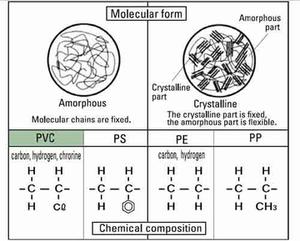
Fire retarding properties
PVC has inherently superior fire retarding properties due to its chlorine content, even in the absence of fire retardants. For example, the ignition temperature of PVC is as high as 455°C, considerably decreasing its risk of catching fire. Furthermore, the heat released when PVC burns is considerably lower compared to PE and PP, therefore making PVC much less likely to spread fire to nearby materials even while burning,
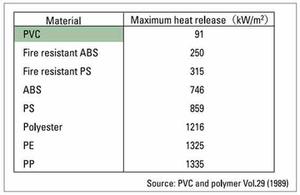
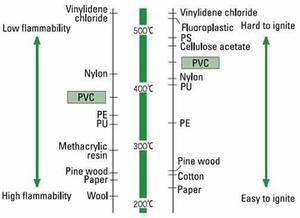
Durability
Under normal conditions of use, the most influential factor in affecting the durability of a material is its ability to resist oxidation by atmospheric oxygen. PVC, having the molecular structure where the chlorine atom is bound to every other carbon chain, is highly resistant to oxidative reactions, therefore maintaining its performance for a long time. Other general purpose plastics with structures made up only of carbon and hydrogen are more susceptible to deterioration by oxidation in extended use conditions (such as, for example, through repeated recycling). Measurements on underground 35 year-old PVC pipes taken by the Japan PVC Pipe & Fittings Association showed no deterioration, the pipes maintaining the same strength as new pipes.
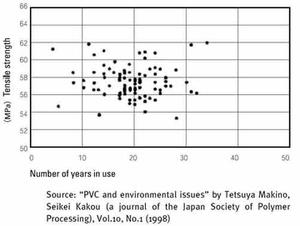
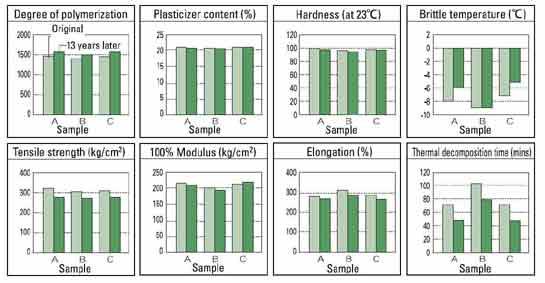
Research in Germany (60 Jahre Erfahrungen mit Rohrleitungen aus Weichmachfreiem PVC, 1995, KRV) analysed pipes buried in soil, dug up after 60 years of active use, proving them to befit for purpose and likely to have a further life expectancy of 50 years! Almost no deterioration was observed upon recovery of three kinds of automobile exterior accessories (flexible PVC products using plasticisers) from end-of-life cars after 13 years of use and upon comparison of physical properties with new products.
The shortened time for thermal decomposition of PVC is due to the heat the material endures as part of the re-converting process (part of recycling), but can be restored by adding stabilisers. Recovered products can in fact be recycled into the same products through re-converting, regardless of whether they are pipes or automobile parts. The physical properties of these re-converted products are almost the same as with products made from virgin resin
Oil/chemical resistance
PVC is resistant to acid, alkali and almost all inorganic chemicals. Although PVC swells or dissolves in aromatic hydrocarbons, ketones, and cyclic ethers, PVC is hard to dissolve in other organic solvents. Taking advantage of this characteristic, PVC is used in exhaust gas ducts, sheets used in construction, bottles, tubes and hoses.
Mechanical stability
PVC is a chemically stable material that shows little change in molecular structure or mechanical strength. However, long chain polymers are viscoelastic materials and can be deformed by continuous application of exterior force, even if the applied force is well below their yield point. This is called creep deformation. PVC’s creep deformation is considerably low compared to other plastics, due to its limited molecular motion at ordinary temperature, whereas PE and PP have greater molecular motion in their amorphous sections.
A European study on very early PVC pipes, carried out from the 1930s to the 1950s, concluded that PVC has a service life of 50 years and excellent durability characteristics. Today, modern PVC pipes are expected to last significantly longer – probably up to or in excess of 100 years.
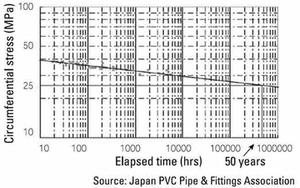
Processability and mouldability
The processability of a thermoplastic material depends largely on its melt viscosity. PVC is not suitable for injection moulding of large sized products, since its melt viscosity is comparatively high. On the other hand, the viscoelastic behaviour of molten PVC is less dependent on temperature and is stable. Therefore PVC is suitable for complex shaped extrusion profiling (e.g., housing materials), as well as calendaring of wide films and sheets (e.g., agricultural films and PVC leather). The exterior surfaces of PVC products are excellent, and display superior embossing performance - enabling a wide variety of surface treatments with textures ranging from enamel gloss to suede. Since PVC is an amorphous plastic with no phase transition, or in other words, does not significantly shink during cooling, PVC products produced in moulds maintain their moulded dimensions with high accuracy. PVC also exhibits excellent on-site workability, as well as secondary processability in bending fabrication, welding, high-frequency bonding and vacuum forming. Paste resin processing such as slush moulding, screen printing and coating are convenient processing techniques that are feasible only with PVC. These processing methods are used in flooring, wall covering, automobile sealants and undercoating.
Other properties that make PVC versatile
PVC has polar groups (chlorine), and is amorphous, therefore mixing well with various other substances. The required physical properties of end products (e.g., flexibility, elasticity, impact resistance, anti-fouling, prevention of microbial growth, anti-mist, fire retarding) can be freely designed through formulation with plasticisers and various additives, modifiers, and colouring agents. PVC is the only general purpose plastic that allows free, wide and seamless adjustment of the required physical properties of products such as flexibility, elasticity, and impact resistance, by adding plasticisers, additives, and modifiers. Since the physical properties of end products are adjustable with additives, only a few types of resin are required to cover all applications (fibre, rigid and flexible plastic, rubber, paint, and adhesive).
